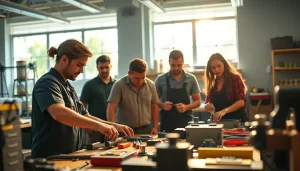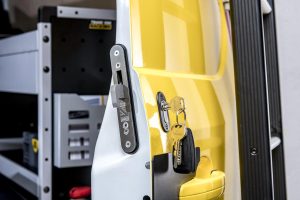Essential Guide to Trade Schools in Hawaii: Training for Tomorrow’s Careers

Understanding Trade Schools in Hawaii
What are Trade Schools?
Trade schools, often known as vocational or technical schools, provide specialized education and training for students who wish to pursue careers in various skilled trades. Unlike traditional educational routes that may focus more broadly on theoretical knowledge, trade schools emphasize practical, hands-on learning in specific trades, allowing students to develop skills directly applicable in the workforce. In Hawaii, these institutions cater to a wide range of industries including construction, healthcare, automotive, and technology. The hands-on experience coupled with industry-focused coursework prepares graduates for immediate employment opportunities in their chosen fields.
The Importance of Trade Education
Trade education plays a crucial role in the economy of Hawaii, giving students the tools they need to enter high-demand jobs. With Hawaii’s unique geography and economic framework, skilled tradespeople are essential to maintain the infrastructure and services essential for both residents and tourists. The shift towards appreciating skilled professions has been gaining momentum, as more students realize the potential for lucrative careers without the burden of traditional four-year college debt. Consequently, prospective students often look into trade schools in Hawaii as a viable and rewarding alternative.
Overview of Available Programs
Trade schools in Hawaii offer varied programs catering to diverse interests and job markets. Popular fields include carpentry, plumbing, electrical work, automotive technology, culinary arts, and healthcare. Each program typically culminates in certifications or licensures recognized by employers within the state. In addition, many schools collaborate with local industries to enhance their curricula and ensure that students receive relevant training that meets current market needs.
Popular Trade Programs in Hawaii
Construction and Skilled Trades
Construction and skilled trades are among the most sought-after programs in Hawaiian trade schools. These programs often include hands-on training in fields such as carpentry, masonry, plumbing, and electrical installation. The construction industry is integral to Hawaii’s economy, offering significant employment opportunities.
For instance, students pursuing a carpentry diploma may learn how to build structures, install frameworks, and interpret blueprints, preparing them for immediate employment in residential or commercial construction projects. Programs are designed to not only teach technical skills but also emphasize the importance of safety regulations and best practices, ensuring that graduates enter the workforce fully equipped for success.
Healthcare and Technical Programs
The healthcare sector in Hawaii is extensive, in part due to the islands’ aging population and the ongoing need for medical professionals. Trade schools offer programs such as nursing assistant training, dental hygiene, and medical coding. These programs emphasize both theoretical knowledge and the practical skills necessary for delivering patient care or managing healthcare systems.
Healthcare programs typically include internship opportunities that allow students to gain field experience in hospitals, clinics, or community health centers. Graduates often find their skills in high demand, with many employers providing support in the form of mentorship or additional training to help them advance their careers.
Automotive and Mechanic Training
Automotive programs train students to tackle the complexities of vehicle repair and maintenance. With Hawaii’s unique set of environmental and performance challenges for vehicles, graduates from these programs can expect versatile career options in auto repair shops, dealerships, or even starting their own businesses.
Students learn about various automotive technologies, diagnostic equipment, and repair processes. Programs often include modules on customer service, essential for building good relationships with clients and growing successful careers in the automotive industry.
Choosing the Right Trade School in Hawaii
Factors to Consider When Selecting a Program
Choosing the right trade school is an important decision that greatly impacts a student’s future. Key considerations when selecting a program include the school’s reputation, available programs, faculty qualifications, and post-graduation job placement rates. Prospective students should visit campuses, if possible, and speak with current students and alumni to gauge the environment and quality of education.
Additionally, it’s wise to consider the language of instruction, especially in a culturally diverse place like Hawaii, where local dialects can influence the learning experience.
Accreditation and Quality Assurance
Accreditation is another pivotal aspect when selecting a trade school. Schools accredited by recognized organizations typically offer rigorous quality education, ensuring that programs meet educational standards. Students who graduate from accredited institutions are often more marketable to employers and may be eligible for federal financial aid programs.
In Hawaii, it’s essential to verify that the trade school you are considering is licensed by the appropriate state and national accrediting bodies. This step guarantees that your education meets quality benchmarks set for various trade occupations, instilling confidence in your skillset.
Financial Aid and Scholarships
Many trade schools offer various financial aid options, including scholarships, grants, and payment plans, enabling students to manage educational costs more effectively. It’s beneficial for prospective students to research financial options early and explore both state and federal funding opportunities. Some schools partner with local industry leaders to provide scholarships and incentives, further easing financial burdens for students.
Additionally, students should consider the overall cost of attending trade school, including tuition, books, tools, and living expenses. Understanding the total financial commitment will help in making informed decisions about the best path forward.
Success Stories from Trade Schools in Hawaii
Real-World Applications of Skills Learned
Students graduating from trade schools in Hawaii often find themselves with success stories that inspire future generations. Many alumni report securing fulfilling jobs shortly after completing their programs, translating their skills directly into the workforce.
For instance, an electrical program graduate might showcase how they quickly moved up within a local contracting company, becoming a site supervisor overseeing large projects within just a few years. Such success is typically a result of not only the education received but also the expertise gained through hands-on experience during apprenticeships and internships.
Alumni Achievements and Testimonials
Testimonials from alumni provide invaluable insights into the effectiveness of trade school programs. Many students share how their education transformed their career trajectories, illustrating the practical benefits of their training. Stories highlight how graduates leveraged their skills to secure promotions, open their own businesses, or transition into teaching the next generation of skilled workers.
These alumni frequently contribute back to their communities, whether through mentorship programs, offering workshops, or participating in vocational training initiatives, thereby creating a supportive cycle of education and skills development within the local population.
Impact on Local Communities
The impact of trade schools reaches beyond individual success, significantly benefiting local economies and communities. By preparing a skilled workforce, trade schools help meet local labor demands, which in turn boosts business growth and sustainability across various sectors. The collaboration between trade schools and local businesses creates pathways for students to transition smoothly into employment, reducing unemployment rates and increasing economic stability.
Moreover, trade schools often engage with local nonprofit organizations to provide training for disadvantaged populations, contributing to the overall improvement of community well-being.
Getting Started with Trade Schools in Hawaii
Steps to Enroll
Enrolling in a trade school typically involves several steps, beginning with research into various programs and schools. After narrowing down choices, prospective students often need to complete an application, providing necessary documentation such as transcripts, references, and any previous work experience relevant to their desired field.
Entry tests or interviews may be part of the admissions process, alongside financial aid applications if needed. Most programs have designated enrollment periods, so it’s vital for students to stay informed about deadlines.
Preparing for Your Education Journey
Once enrolled, students should take proactive steps to prepare for their educational journey. This may involve purchasing tools or materials needed for class, familiarizing themselves with course syllabi, and connecting with fellow students for support. Moreover, students should attend orientation sessions, if offered, to become acquainted with faculty and understand the resources available at the trade school.
Connecting with Employers and Internships
Most trade schools prioritize building relationships with local employers to facilitate internships and job placements for their students. Engaging in these opportunities not only allows students to apply their skills in real-world scenarios but also expands their professional networks. Students should actively participate in career fairs, workshops, and networking events organized by their trade schools to maximize these connections.
These engagements often lead to job offers even before graduation, demonstrating the strong link between trade school education and workforce readiness.







